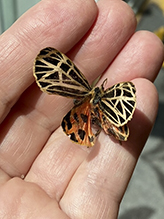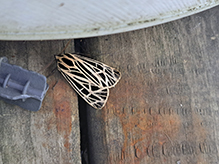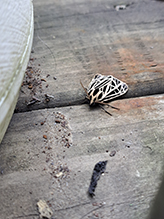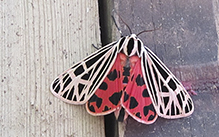virgin tiger moth
(Apantesis virgo)
Conservation • Description • Habitat • Ecology • Distribution • Taxonomy
|
||||||||
| Hodges # | 8197 |
|||||||
Conservation Status |
||||||||
| IUCN Red List | not listed |
|||||||
| NatureServe | NNR - Unranked |
|||||||
| Minnesota | not listed |
|||||||
Description |
||
Virgin tiger moth is a medium-sized moth, but it is the largest moth in the genus Apantesis. It occurs in the United States from Maine to Georgia west to North Dakota and Nebraska, and in southern Canada from Newfoundland to British Columbia. It is found in open hardwood forests, moist meadows, and other open areas. Larvae feed on a wide variety of low-growing herbaceous plants, including clover, lettuce, and plantain. Adults do not feed. Adults are 15⁄16″ to 1 7⁄16″ (24 to 37 mm) in length and have a wingspan of about 2¼″ (56 mm). The thorax is striped black and buff or creamy-buff. The abdomen is orange to orangish-pink with a large black spot on the upper side of each segment (middorsal). The wings are held over the body like a roof when at rest. The male forewing length averages ⅞″ (22.2 mm). The forewing is black with pale, yellowish-buff to creamy-buff markings. The veins, lines, discal spot, leading edge (costal margin), inner margin, and fringe are all pale. The media vein (M) is wider than the anal vein (A). The antemedial (AM) band is usually absent, sometimes represented by a slightly pale bar along the vein on the costal margin (costa). There is a bent transverse line at the end of the discal cell. The postmedial (PM) and subterminal (ST) bands are bold lines. The hindwing is pink to orangish pink, rarely yellow, with somewhat variable black markings. There is always a costal and anal spot, and well-developed PM and ST spots. There is almost always a well-developed discal spot. The PM and ST spots are not joined except near the margin at the anal angle. The antennae are black. On the male they are feathery, with extensions along both sides of the shaft (bipectinate). The antennae on the female are slender and thread-like. The above description refers to the nominate subspecies A. v. virgo, the only subspecies that occurs in Minnesota. The southeastern subspecies A. v. gigas is much larger, the male forewing length averages 1 3⁄16″ (29.2 mm), and the hindwing colors are brighter and more saturated. Caterpillars in the genus Apantesis are difficult to identify to the species level. |
||
Size |
||
Total length: 15⁄16″ to 1 7⁄16″ (24 to 37 mm) Wingspan: about 2¼″ (56 mm) |
||
Similar Species |
||
Habitat |
||
Open hardwood forests, moist meadows, and other open areas |
||
Ecology |
||
Season |
||
One generation per year: June to mid-July |
||
Behavior |
||
The wings are held over the body like a roof when at rest. When threatened, the wings are spread, exposing the pink underwings, and presenting a more intimidating display. |
||
Life Cycle |
||
Caterpillars overwinter |
||
Larva Hosts |
||
A wide variety of low-growing herbaceous plants, including clover, lettuce, and plantain. |
||
Adult Food |
||
Adults do not feed. |
||
Distribution |
||||
|
Sources |
|||
| 7/29/2023 | ||||
Occurrence |
||||
Common |
||||
Taxonomy |
|||
Order |
|||
Superfamily |
Noctuoidea (Owlet Moths and Allies) |
||
Family |
Erebidae (Underwing, Tiger, Tussock, and Allied Moths) |
||
Subfamily |
Arctiinae (tiger moths and allies) |
||
Tribe |
Arctiini (tiger moths) |
||
Subtribe |
Arctiina |
||
Genus |
Apantesis |
||
Family Genus |
|||
Subordinate Taxa |
|||
virgin tiger moth (Apantesis virgo gigas) virgin tiger moth (Apantesis virgo virgo) |
|||
Synonyms |
|||
Bombyx virgo Euprepia virgo var. citrinaria Grammia virgo |
|||
Common Names |
|||
virgin tiger moth |
|||
Glossary
Antemedial (AM) line
A thin line separating the basal area and the median area of the forewing of Lepidoptera.
Costa
On ferns: The central axis of a pinna, to which pinnules are attached. On mosses: the central axis (midvein) of a leaf. On insects: The vein on the leading edge of the forewing.
Costal margin
The leading edge of the forewing of insects.
Postmedial (PM) line
A thin line separating the median area and the postmedial area of the forewing of Lepidoptera.
Visitor Photos |
|||||
Share your photo of this insect. |
|||||
| This button not working for you? Simply email us at info@MinnesotaSeasons.com. Attach one or more photos and, if you like, a caption. |
|||||
Mindy Howell |
|||||
I found this deceased moth. I had never seen one before. |
|||||
 |
|||||
Alicia Richardson |
|||||
Virgin Tiger Moth located in Decker Michigan Discovered this little guy on my porch. Never seen one before. I live in Decker, Michigan 48426 Had to share!!! |
 |
||||
 |
 |
||||
Bobbi Johnson |
|||||
seen in our yard |
|||||
 |
|||||
MinnesotaSeasons.com Photos |
|||||
|
|||||

Visitor Videos |
|||
Share your video of this insect. |
|||
| This button not working for you? Simply email us at info@MinnesotaSeasons.com. Attach a video, a YouTube link, or a cloud storage link. |
|||
Other Videos |
|||
| Virgin Tiger Moth (Arctiidae: Grammia virgo) Carl Barrentine |
|||
About
Jul 7, 2010 Photographed at the Rydell NWR, Minnesota (07 July 2010). |
|||
| Virgin Tiger Moth (Grammia virgo) - Insect Rescue Lake Superior Lycan |
|||
About
Jul 22, 2020 I save a beautiful moth from drowning and dry it out so it can fly away at the best beach on Lake Superior. The Virgin Tiger moth have been in an evolutionary battle with bats regarding their echolocation and how quick they react to the sounds of a bat ( 40 to 100 milliseconds). The virgin tiger moth has very developed hearing of high frequency sounds and even created their own ultrasonic sounds to outsmart the bats hearing capabilities. These moths are beautiful but it is also a warning of its awful taste to predators. If handled improperly they will secret a yellow pungent liquid from its head or shoulder area, I’m glad it didn’t do that to me! They are a very interesting insect and have a last ditch effort of surviving a bat attack by flying erratically or just falling from the air. |
|||

Visitor Sightings |
|||||
Report a sighting of this insect. |
|||||
| This button not working for you? Simply email us at info@MinnesotaSeasons.com. Be sure to include a location. |
|||||
| Mindy Howell 7/31/2023 |
Location: Medina, Ohio I found this deceased moth. I had never seen one before. |
||||
| Alicia Richardson 7/28/2023 |
Location: Decker, Michigan 4842 Discovered this little guy on my porch. Never seen one before. I live in Decker, Michigan 48426 Had to share!!! |
||||
| Bobbi Johnson 7/10/2021 |
Location: Silver Bay, MN seen in our yard |
||||
MinnesotaSeasons.com Sightings |
|||||
|
|||||

Created: 8/6/2021
Last Updated:





